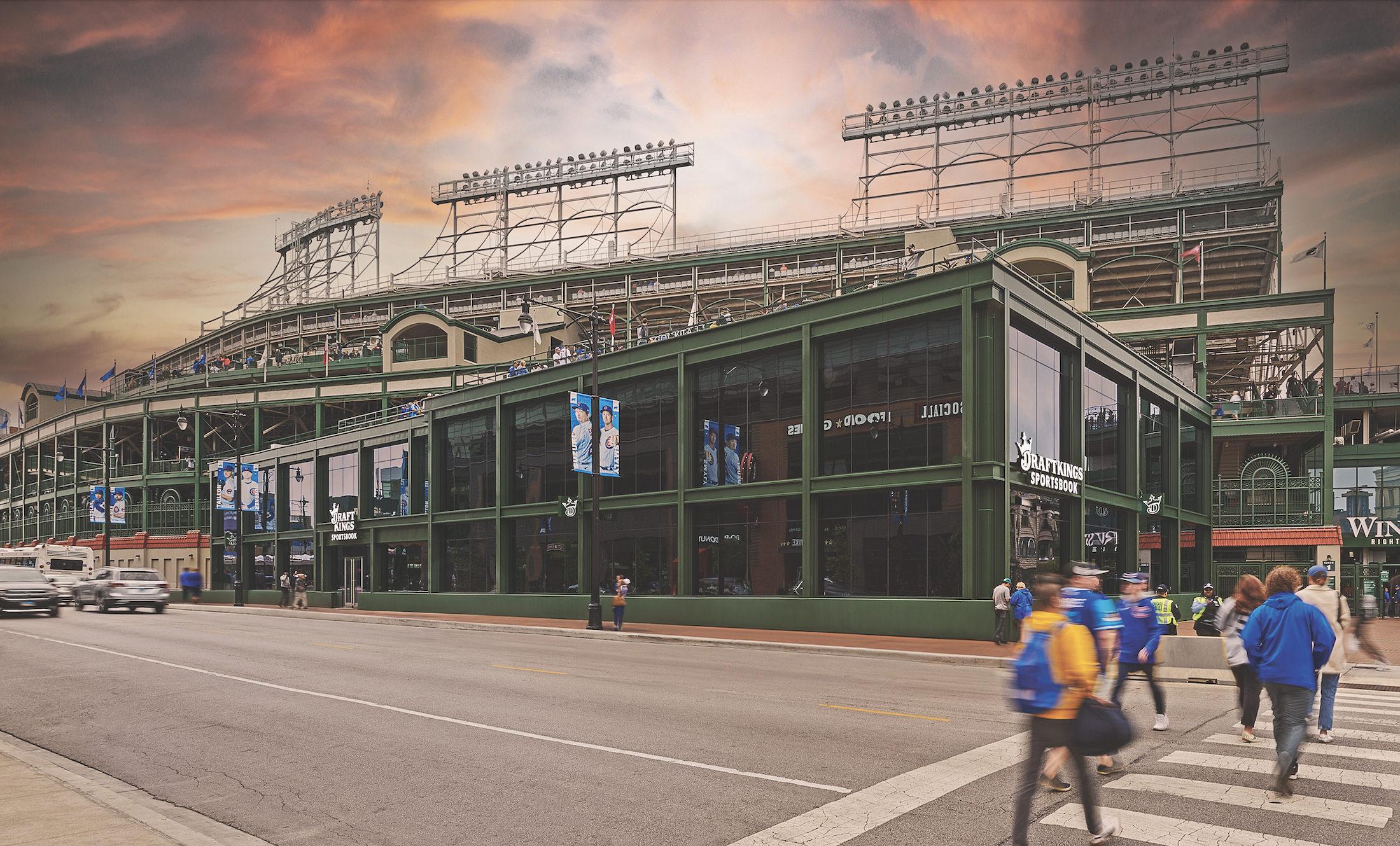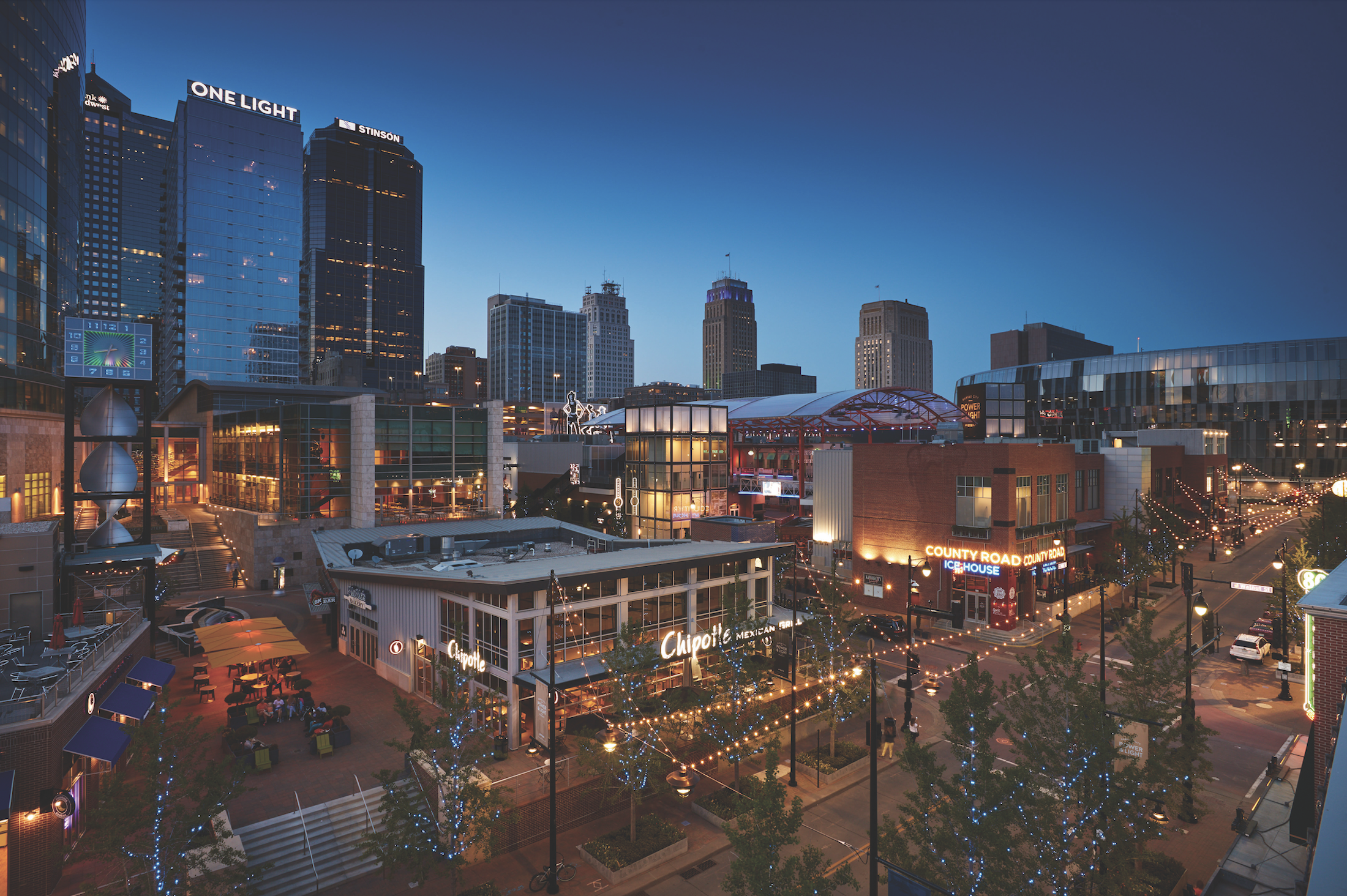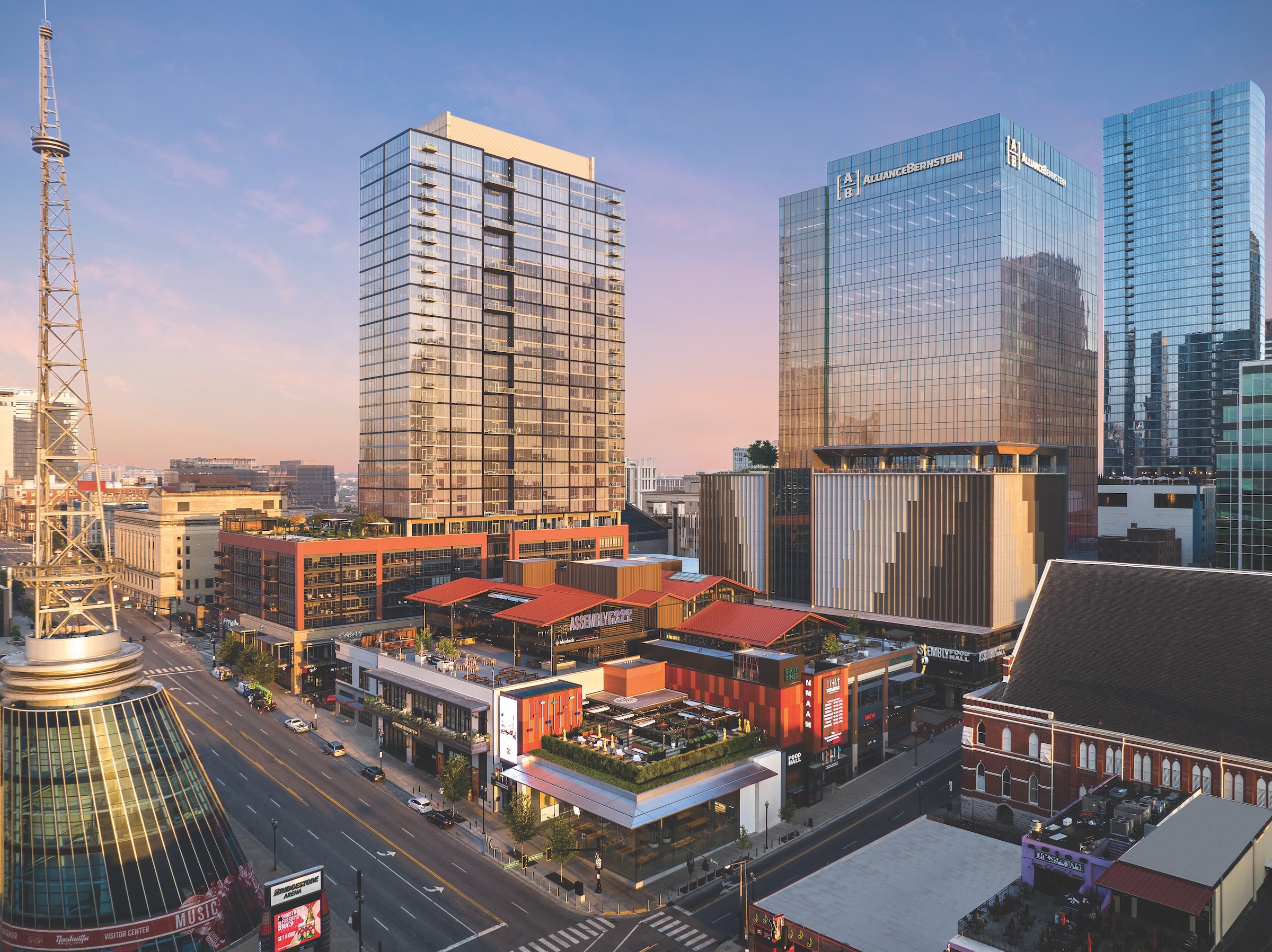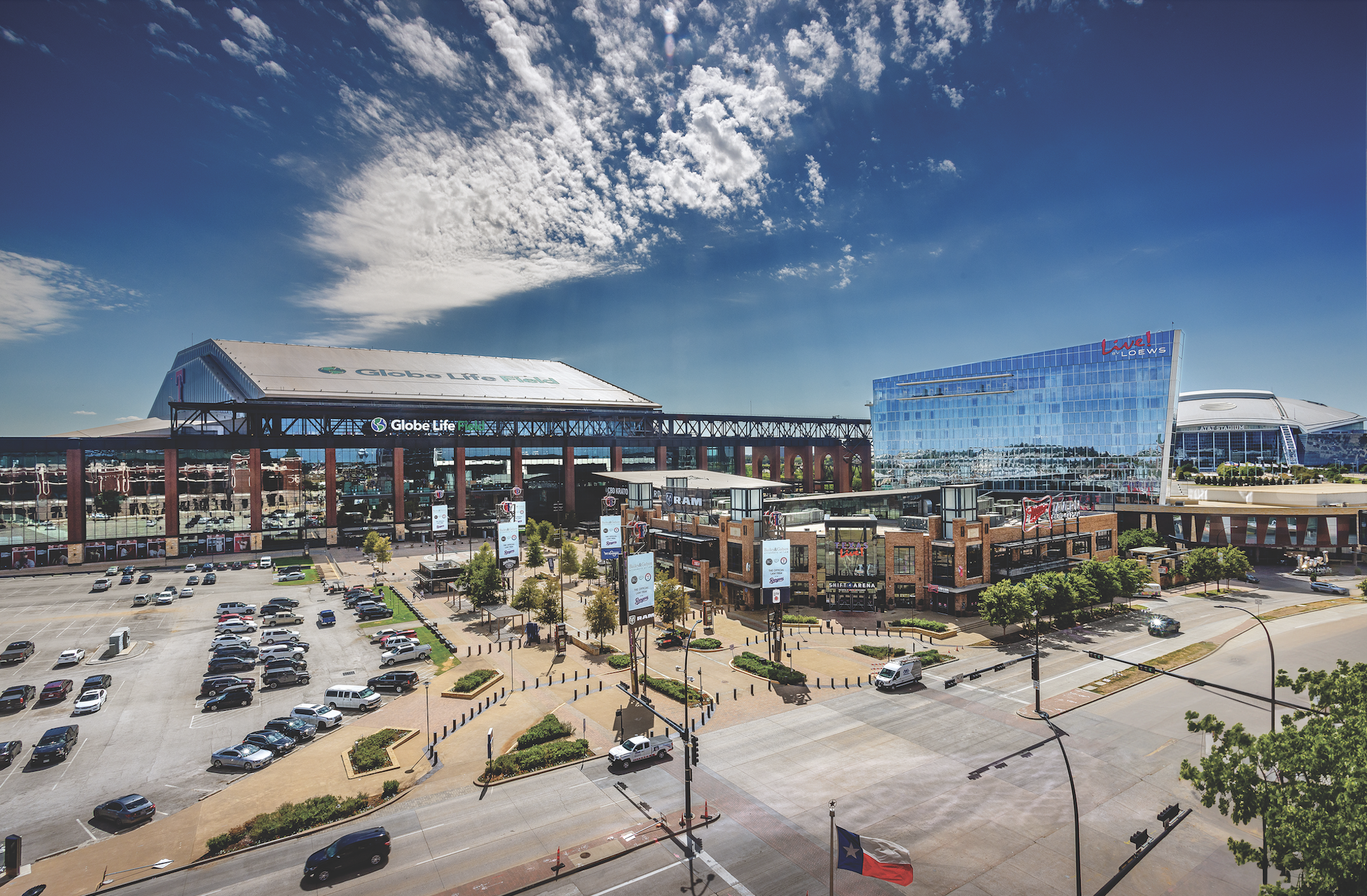On September 6, a group of business, civic, and university leaders known as Team Norman presented what they saw as two possible futures for Norman, Okla., that state’s third-largest city: either remain a bedroom community in the shadow of the University of Oklahoma (OU) or strive to become “a unique destination,” said Norman’s Mayor Larry Heikkila. The city craves the latter direction, asserted Lawrence McKinney, President of the Norman Economic Development Coalition, a conclusion based on his group’s 400 hours of listening to stakeholders and constituents in the region.
Team Norman used this meeting to promote its proposal for a $1 billion entertainment district, a mixed-use development on 200 acres adjacent to Max Westheimer Airport, which would include a new multipurpose arena that replaces the 48-year-old, 11,000-seat Lloyd Noble Center on OU’s campus, which McKinney tells BD+C is no longer adequate for creating the kind of experiences that fans and visitors expect.
Norman is one of a growing number of metros that are staking their futures on the vitality and drawing power of entertainment districts (see sidebar on page 24). Some of the recent proposals would touch only a few blocks; others are massive undertakings with matching price tags.
These proposals often mirror the mix of buildings found within existing districts, the most successful of which are those that refuse to stand pat and evolve to provide visitors—and, increasingly, workers and residents—with new reasons to live, work, and play there.
In May 2022, Clearline Real Estate paid $19.75 million for a 0.9-acre development site in the heart of Downtown Miami’s Arts & Entertainment District. Sixteen months later, Clearline and Shawmut Design and Construction announced that they would build a 24-story, 338,000-sf tower on that site called Excel Miami, consisting of 427 apartments, half of them micro units. “Miami’s Arts & Entertainment District was the missing piece to create an easily accessible, fully walkable cultural spine running the north-south strip of the city,” explains Alexis Leal, Shawmut’s Head of Florida. “Creating housing in this opportunity zone fills a need and brings critical mass to an area that has transformed immensely.”
Financing poses challenges for entertainment districts
Even as their popularity expands, entertainment districts still get occasional pushback from municipalities, usually over who’s footing the bill. (Rezoning seems to be less of an obstacle, according to the developers interviewed by BD+C.) In 2018, a $91 million plan by the city of Norman to create a district with an arena derailed over requests for tax incentives. Last May, city officials in Tempe, Ariz., concluded they didn’t have voter support for three propositions related to a new entertainment district that included a new arena for the financially troubled Arizona Coyotes NHL franchise.
Even projects that are moving forward must figure out ways to pay for their developments that are palatable to voters. Several of the districts being proposed, like Miami Freedom Park, would be privately funded, wholly or partly. The city of Anaheim, Calif., reportedly plans to float $400 million in bonds to help defray the cost of its ocV!BE district. In St. Louis, Green Street Real Estate Ventures has been working on getting tax credits to redevelop the 1.5 million-sf Famous Barr Warehouse as part of its Armory STL district proposal. Norman’s district would be folded into a tax increment financing district that uses property taxes to improve the local built environment. Norman officials also debated whether the proposed entertainment district might require bond financing.

However, the cost factor hasn’t impeded demand or enthusiasm for entertainment districts, and there are myriad reasons why these projects continue to be sought-after solutions for urban revitalization.
For one thing, there are plenty of successful precedents: Populous, the architectural design firm that has several entertainment district designs under its belt, works with feasibility partners that track economic data in districts. Three markets where there have been notable urban transformations sparked by sports-anchored venues are Washington, D.C. (around Audi Field and Nationals Park), Denver’s LoDo and Diamond District (around Coors Field), and Milwaukee’s Deer District (around Fiserv Forum). John Shreve, Populous’ Senior Principal and Senior Urban Planner, notes that Battery Atlanta, the year-round entertainment district, draws more than double the three million fans who attend Atlanta Braves home games at the district’s anchor stadium, Truist Park, seasonally.
Municipalities also like entertainment districts because they generate tax revenue, and lure visitors who might otherwise sidestep that part of the city. Janet Long, Pinellas County (Fla.) Commission chairperson, was quoted as calling the planned Tampa Bay ballpark and entertainment district—the largest development project in the county’s history—an “unprecedented opportunity with huge economic, workforce, and quality of life potential for our residents.” Michael Harrison, Senior Managing Director of Hines, the managing developer on this project, added that his firm’s goal is to create “one of the most exciting placemaking destinations in the world.”
Related: 12 U.S. markets where entertainment districts are under consideration or construction
In Norman, the goals of the proposed entertainment district are manifold: to attract newcomers to a state that has only 53 workers for every 100 available jobs; to generate revenue for a city that currently isn’t zoned for retail and is located just north of the state’s busiest shopping mall, University Town Center, which draws 60% of its patrons from outside Cleveland County; and to add more housing for a city whose population is expected to increase 52,000 by 2040.
Indeed, the consensus holds that entertainment districts set the stage for broader construction and renovation around the district. John Moncke, President of Kansas City Power & Light District, which attracts some 10 million visitors annually, tells BD+C that this district, when it first opened 16 years ago, was intended to catalyze the downtown area, and its impact since “can be felt well beyond its original nine city blocks.”
Sustaining traffic during the off season
The multipurpose arena T-Mobile Center is on the east side of KCP&LD. Many other existing and proposed entertainment districts revolve around stadiums and arenas with built-in fan bases. But the most successful districts also feature building types that attract people when teams aren’t playing.
This sports-district nexus is sometimes the result of professional team owners also being developers. One thriving template is Battery Atlanta, the 2.25 million-sf entertainment district owned by the Braves Development Company, which features hospitality, dining, shopping, 500-plus residential units, performance space, and corporate office options.
A recent article posted on SB Nation’s Royals Review site, about the Kansas City Royals’ two district proposals, noted that through the six months ending June 30, the Braves’ baseball operations had an operating income of $10.58 million on revenue of $272.5 million. While Battery Atlanta’s revenue over that same period was only $28.6 million, its operating income was $16.4 million. And the Braves aren’t obligated to share the district’s proceeds with the rest of the league.
Those profitability comparisons notwithstanding, a sports venue that’s sited within or near an entertainment district is generally considered a net positive. Robert Weis, Gensler’s Global Leader–Immersive Experience Design, believes that districts can be “complimentary” to sports venues, and take advantage of their infrastructure. Jon Niemuth, Director of Gensler Sports, adds that districts are evolving to the point where “it’s not about sports so much anymore as the experience. It’s culture and sports, or sports and food, or sports and music, culture, and housing.”
Phil Hulse, Founder and CEO of Green Street Real Estate Ventures, concedes that sports-anchored districts “are one way to go.” And Armory STL would be in the same neighborhood as Enterprise Center, where the St. Louis Blues hockey franchise plays, and a major league soccer field. But his pitch for Armory STL was that it would also be near universities and innovation hubs, and be a part of Midtown’s 13 historic neighborhoods.
Housing now a staple component of entertainment districts
Several sources interviewed for this article agree that diversity of experiences is what makes entertainment districts tick these days. That’s one reason, these sources contend, why offices continue to be included in district proposals. And in their efforts to emerge as year-round destinations, more districts are either including residential in their proposals or supporting existing districts with housing.
Populous has been working on the redevelopment of Pittsburgh’s North Shore for 25 years, says Shreve. It designed the district’s master plan and its two stadiums. At first, housing wasn’t seen as essential to the district’s growth. But what became evident was the lack of vitality in the district after hours and on non-game days. Since then, says Shreve, the sports teams and their development partner have introduced a residential project next to the district’s ballpark that will bring 100 new apartments to the North Shore.


The 2,700-acre Arlington Entertainment District in Texas draws some 15 million visitors per year. It includes two stadiums (for the Dallas Cowboys and Texas Rangers), two Six Flags theme parks, a 302-key Loews hotel, and the 300,000-sf Texas Live! entertainment, dining, and performance venue. Private investments in this district have totaled $3.9 billion so far.
Arlington is an example of a district that’s not content to rest on its laurels. It recently opened a 30,000-sf two-level coworking space called Spark Arlington with 61 private offices. Next year, its additions will include an 880-key Loews Arlington hotel with a 266,000-sf convention center, and the Arlington Museum of Art, which is relocating from its long-time downtown home to a 48,000-sf space that’s eight times larger inside the district’s Esports Stadium and Expo Center.
In April 2025, the Arlington Entertainment District will open a $150 million Medal of Honor Museum. That same month, Cordish and the Texas Rangers baseball club are expected to complete One Rangers Way, the district’s first foray into housing. This $70 million, 299-unit community, designed by Hord Coplan Macht, will include 43,000 sf of amenities.
Brent DeRaad, President and CEO of the Arlington Convention & Visitors Bureau, tells BD+C that finding growth-minded private-sector partners like Loews, Cordish, and the sports teams, is critical to maintaining an entertainment district’s dynamism.
Roy Decker, President of Mississippi-based Duvall Decker Architects, which conducted the site-selection study for the Museum of Art, says that the availability of the district’s Expo Center, with its tall ceilings and already-in-place technology, made the relocation decision a no brainer. Decker adds that the museum’s programming—it doesn’t have a permanent collection and has experimented with immersive exhibits—and the coincidental opening of the Medal of Honor Museum next to the Expo Center, fit well with the district’s evolution as a cultural center.
Variety will define future districts
It’s not uncommon now for cities to have multiple districts. The new Nashville Live! venue, for example, will be only blocks from Fifth + Broadway, a live-work-play development that opened in June 2021. Developers and owners don’t sound overly concerned about possible market saturation. At the same time, districts are emphasizing their unique features. For example, ocV!BE in Anaheim would include an on-site solar farm that generates 6 MWs of power. Hulse of Green Street says his plans include building a data center that could draw power from a substation near Famous Barr Warehouse.

In Kansas City, where multiple entertainment districts are either operating or on the drawing board, Pennway Point would be different in that it would be family friendly with a midnight shutdown, says Dante Passantino, Managing Director of DaVinci, its master-tenant developer.
“The longevity of the built world depends on the diversity of uses that animate it every day,” says Riki Nishimura, Populous’ Principal and Senior Urban Designer. Gensler’s Weis suggests that district developers need to find anchors that project the essence of their cities and make it accessible. (Weis likes science and technology centers as options.)
During Team Norman’s proposal presentation, Mayor Heikkila spoke about future plans for other themed districts that include a “weather exploratorium,” a STEAM-focused museum for which Nashville-based D&G Consultants recently completed a feasibility study.
McKinney, President of Norman’s economic development coalition, elaborates that there are five or six areas around the city being considered for themed districts, including a 700-acre site in east Norman that the city has owned for 100 years. He cautions, however, that the funding to purchase land for any future developments will depend on revenues generated by the initial entertainment district being proposed. That district’s approval, he said in late September, “is in the hands of the city council.”
Related Stories
| Jan 19, 2011
San Diego casino renovations upgrade gaming and entertainment
The Sycuan Casino in San Diego will get an update with a $27 million, 245,000-sf renovation. Hnedak Bobo Group, Memphis, Tenn., and Cleo Design, Las Vegas, drew design inspiration from the historic culture of the Sycuan tribe and the desert landscape, creating a more open space with better circulation. Renovation highlights include a new “waterless” water entry feature and new sports bar and grill, plus updates to gaming, poker, off-track-betting, retail, and bingo areas. The local office of San Francisco-based Swinerton Builders will provide construction services.
| Dec 17, 2010
Vietnam business center will combine office and residential space
The 300,000-sm VietinBank Business Center in Hanoi, Vietnam, designed by Foster + Partners, will have two commercial towers: the first, a 68-story, 362-meter office tower for the international headquarters of VietinBank; the second, a five-star hotel, spa, and serviced apartments. A seven-story podium with conference facilities, retail space, restaurants, and rooftop garden will connect the two towers. Eco-friendly features include using recycled heat from the center’s power plant to provide hot water, and installing water features and plants to improve indoor air quality. Turner Construction Co. is the general contractor.
| Dec 17, 2010
Toronto church converted for condos and shopping
Reserve Properties is transforming a 20th-century church into Bellefair Kew Beach Residences, a residential/retail complex in The Beach neighborhood of Toronto. Local architecture firm RAWdesign adapted the late Gothic-style church into a five-story condominium with 23 one- and two-bedroom units, including two-story penthouse suites. Six three-story townhouses also will be incorporated. The project will afford residents views of nearby Kew Gardens and Lake Ontario. One façade of the church was updated for retail shops.
| Dec 2, 2010
GKV Architects wins best guest room design award for Park Hyatt Istanbul
Gerner Kronick + Valcarcel, Architects, PC won the prestigious Gold Key Award for Excellence in Hospitality Design for best guest room, Park Hyatt Macka Palas, Istanbul, Turkey. Park Hyatt Maçka Palace marries historic and exotic elements with modern and luxurious, creating a unique space perpetuating Istanbul’s current culture. In addition to the façade restoration, GKV Architects designed 85 guestrooms, five penthouse suites, an ultra-hip rooftop bar, and a first-of-its-kind for Istanbul – a steakhouse, for the luxury hotel.
| Nov 16, 2010
CityCenter’s new Harmon Hotel targeted for demolition
MGM Resorts officials want to demolish the unopened 27-story Harmon Hotel—one of the main components of its brand new $8.5 billion CityCenter development in Las Vegas. In 2008, inspectors found structural work on the Harmon didn’t match building plans submitted to the county, with construction issues focused on improperly placed steel reinforcing bar. In January 2009, MGM scrapped the building’s 200 condo units on the upper floors and stopped the tower at 27 stories, focusing on the Harmon having just 400 hotel rooms. With the Lord Norman Foster-designed building mired in litigation, construction has since been halted on the interior, and the blue-glass tower is essentially a 27-story empty shell.
| Nov 3, 2010
Rotating atriums give Riyadh’s first Hilton an unusual twist
Goettsch Partners, in collaboration with Omrania & Associates (architect of record) and David Wrenn Interiors (interior designer), is serving as design architect for the five-star, 900-key Hilton Riyadh.
| Oct 6, 2010
From grocery store to culinary school
A former West Philadelphia supermarket is moving up the food chain, transitioning from grocery store to the Center for Culinary Enterprise, a business culinary training school.
| Sep 30, 2010
Luxury hotels lead industry in green accommodations
Results from the American Hotel & Lodging Association’s 2010 Lodging Survey showed that luxury and upper-upscale hotels are most likely to feature green amenities and earn green certifications. Results were tallied from 8,800 respondents, for a very respectable 18% response rate. Questions focused on 14 green-related categories, including allergy-free rooms, water-saving programs, energy management systems, recycling programs, green certification, and green renovation.
| Sep 13, 2010
Conquering a Mountain of Construction Challenges
Brutal winter weather, shortages of materials, escalating costs, occasional visits from the local bear population-all these were joys this Building Team experienced working a new resort high up in the Sierra Nevada.













